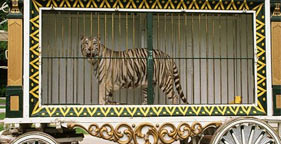CIRCUS MYTHS
 |
|
Every day in America, a circus comes to town. The advertisements promise safe, family fun, colorful costumes, and exotic animals performing tricks at the snap of their trainers' fingers—big cats jumping through burning hoops, elephants balancing on their hind legs, and bears riding bicycles. But there's something no circus wants you to see: the suffering of the animals.
The Humane Society of the United States has monitored circuses for 20 years, chronicling training methods and living conditions that the animals routinely experience. We have kept track of incidents and anecdotes that explode many of the myths that circuses want you to believe—myths that help them perpetuate the big lie behind the big top.
Myth #1: Circus animals perform tricks out of love for their trainers.
Fact: While circus promoters claim that trainers use only positive reinforcement, or rewards, reports prove otherwise. Circus training methods include beating animals with clubs and other objects (even during performances) and depriving them of food. Trainers sometimes strike elephants with sharpened hooks, which can result in physical injury. Trainers resort to brutal methods to maintain a position of dominance. Yet wild animals will always behave in instinctive and unpredictable ways and can never be made willing or safely manageable through training.
Myth #2: Circus animals are like beloved children, taught and nurtured their whole lives.
Fact: Many circus animals are leased seasonally from dealers. The animals move from circus to circus, following seasonal contracts. Many circuses don't bother to provide regular, competent veterinary care. Animals who aren't obedient or who have grown too old to perform may be sold or given to zoos, roadside attractions, research laboratories, or private individuals—options unlikely to improve their quality of life.
Myth #3: After the show, the animals rest in comfort.
Fact: After the show, the animals are locked in cages and shipped to the next town. Circus animals spend much of their lives in small, often dirty cages, barely able to turn around. Circus animals often are shipped in trucks and railway cars without heat or air conditioning and often are deprived of food and water for extended periods.
Myth #4: The circus is safe fun for the whole family.
Fact: People, as well as animals, are injured at circuses. In 1995, an elephant named Tyke charged through an audience in Honolulu after killing one circus employee and injuring another. Tyke was shot to death on a city street. In 1990, a chimpanzee abandoned his motorcycle act, rushed into the stands, and bit a child. In 1994, a baby elephant named Mickey was beaten during a performance. A month later, during another performance, Mickey attacked a child.
Myth #5: Circuses serve endangered species by educating children and adults.
Fact: Watching wild animals perform unnatural tricks outside their natural habitats doesn't teach people anything about the animals. By displaying bears as tricycle-riding buffoons and by dressing elephants in tutus, circuses present animals as creatures whose purpose is to amuse us.
Myth #6: Laws protect animals in circuses.
Fact: While standards for handling, care, treatment, and transport are written into the federal Animal Welfare Act (administered by the U.S. Department of Agriculture), those standards are minimal and poorly enforced. Persistent violators are rarely prosecuted.
(Source: circuses.com)